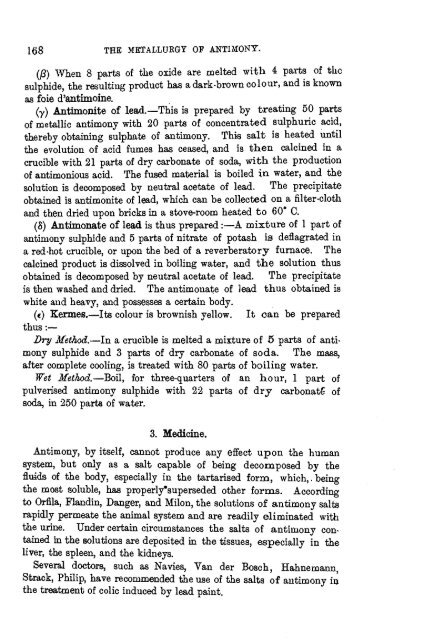antimony - Sciencemadness.org
antimony - Sciencemadness.org
antimony - Sciencemadness.org
You also want an ePaper? Increase the reach of your titles
YUMPU automatically turns print PDFs into web optimized ePapers that Google loves.
168 THE METALLURGY OF ANTIMONY.<br />
(J3) When 8 parts of the oxide are melted with 4 parts of the<br />
sulphide, the resulting product has a dark-brown colour, and is known<br />
as foie d'antimoine.<br />
(y) Antimonite of lead.—This is prepared by treating 50 parts<br />
of metallic <strong>antimony</strong> with 20 parts of concentrated sulphuric acid,<br />
thereby obtaining sulphate of <strong>antimony</strong>. This salt is heated until<br />
the evolution of acid fumes has ceased, and is then calcined in a<br />
crucible with 21 parts of dry carbonate of soda, with the production<br />
of antimonious acid. The fused material is boiled in water, and the<br />
solution is decomposed by neutral acetate of lead. The precipitate<br />
obtained is antimonite of lead, which can be collected on a filter-cloth<br />
and then dried upon bricks in a stove-room heated to 60° C.<br />
(8) Antimonate of lead is thus prepared:—A mixture of 1 part of<br />
<strong>antimony</strong> sulphide and 5 parts of nitrate of potash is deflagrated in<br />
a red-hot crucible, or upon the bed of a reverberatory furnace. The<br />
calcined product is dissolved in boiling water, and the solution thus<br />
obtained is decomposed by neutral acetate of lead. The precipitate<br />
is then washed and dried. The antimonate of lead thus obtained is<br />
white and heavy, and possesses a certain body.<br />
(c) Kennes.—Its colour is brownish yellow. It can be prepared<br />
thus:—<br />
Dry Method.—In a crucible is melted a mixture of 5 parts of <strong>antimony</strong><br />
sulphide and 3 parts of dry carbonate of soda. The mass,<br />
after complete cooling, is treated with 80 parts of boiling water.<br />
Wet Method.—Boil, for three-quarters of an hour, 1 part of<br />
pulverised <strong>antimony</strong> sulphide with 22 parts of dry carbonate* of<br />
soda, in 250 parts of water.<br />
3. Medicine.<br />
Antimony, by itself, cannot produce any effect upon the human<br />
system, but only as a salt capable of being decomposed by the<br />
fluids of the body, especially in the tartarised form, which,.being<br />
the most soluble, has properly*superseded other forms. According<br />
to Orfila, Flandin, Danger, and Milon, the solutions of <strong>antimony</strong> salts<br />
rapidly permeate the animal system and are readily eliminated with<br />
the urine. Under certain circumstances the salts of <strong>antimony</strong> contained<br />
in the solutions are deposited in the tissues, especially in the<br />
liver, the spleen, and the kidneys.<br />
Several doctors, such as Navies, Van der Bosch, Hahnemann,<br />
Strack, Philip, have recommended the use of the salts of <strong>antimony</strong> in<br />
the treatment of colic induced by lead paint.
















